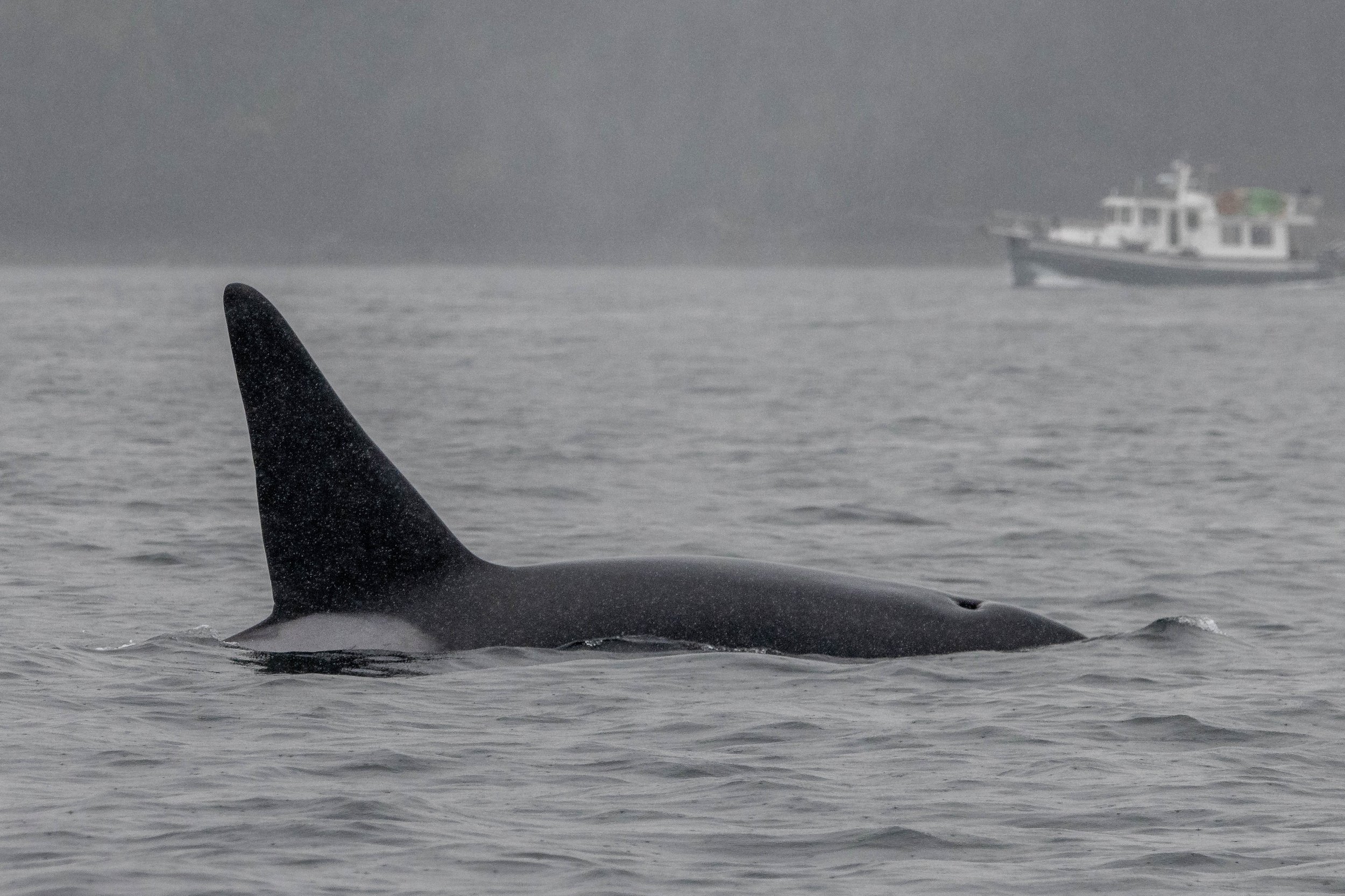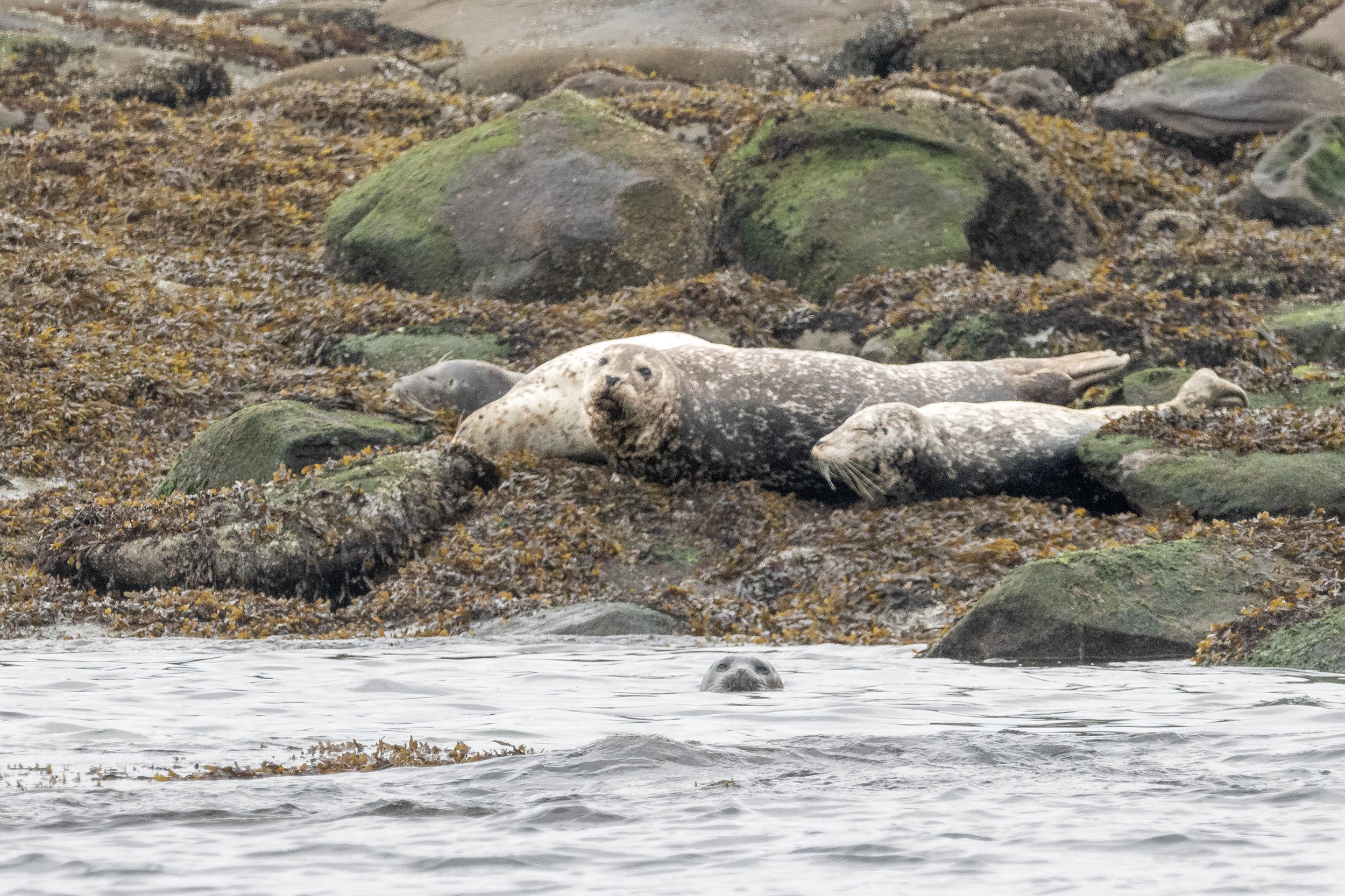August 23, 2024, 10:30 AM - A Rainy Morning Spent with the T002Cs and Olympus!
It was an overcast yet calm day as all three of our boats left the harbour this morning. Every morning we leave the dock is a clean slate, we have to find the whales just by looking since none of the whales here are tagged or tracked. We of course work with other whale watch companies in the area to provide the best experiences for all of our guests, but we also are confident in our own ability to find whales! Today, our naturalist onboard the semi-covered vessel found a pod of orcas. We took one look at the fins and knew we had a pod of Transient or marine mammal-eating killer whales.
T002C Tasu ♀ (1989)
T002C1 Rocky ♂ (2002)
T002C3 Lucy ♀ (2011)
T002C5 “Zippy” (2021)
The T002s have quite a story. In the early days of photo identification, we didn’t have the alphanumeric system, so orcas were given the next number available. Tasu’s mom was T002 Florencia, who was also called Pointednose Cow in the very early days of her being discovered. In the late 1960s and 1970s, captures of killer whales for aquariums were quite common, especially in British Columbia and Washington State. In 1970, Florencia, along with her presumed offspring T001 Charlie Chin, T005 Nootka, and presumed sister T003 Scarredjaw Cow with her daughter T004 Chimo. Unfortunately, Nootka and Chimo were taken into captivity, Scarredjaw Cow died, and Florencia and Charlie Chin eventually got to swim free once more.
Florencia went on to have three offspring: T002A Bajo, T002B Pedder, and T002C Tasu. Tasu has since had five calves, three of which are still alive today. Her oldest offspring, Rocky, is a very impressive whale and we loved getting to see him today! The whales moved slowly in the Strait of Georgia, zig-zagging around until they came to Hudson Rocks, where they exhibited hunting behaviour. We know it was successful when we saw not one, but two spyhops! They then went closer to shore and started moving slowly north.
We also got to spend time with Humpback Whale Olympus (BCX2075). She wasn’t moving forward very much and not sticking her dorsal fin out of the water as much as we usually see. We could tell she was fast asleep! Whales don’t sleep like us. Since they are conscious breathers, they need to think about coming to the surface every time. If they turned their whole brain off like us, it wouldn’t go very well. Instead, they exhibit Uni-hemispherical sleep. In simpler words, they turn half of their brain off at once so it can rest, and the other half remains on to remember to breathe. This means they can also keep swimming and diving just like Olympus was doing.
Unfortunately, we were running out of time on our tour so we left Olympus to her sleeping and headed over to Snake Island. Usually, we can find some Harbour Seals right along the rocks near the water, but today they all decided that the pebbled beach was a great spot to snooze! We got to see the range of colours seals have! From sandy browns to near-black, they’re all different!
We had just enough time to also squeeze in a visit to the Gabriola Bluffs. We primarily find cormorants nesting here, but today we also got to see Turkey Vultures. The tide was also low enough for us to spot some ochre sea stars and anemones clinging to the sandstone. It’s always a fun day to add these small invertebrates to our list of wildlife. All too soon it seemed, we had to head back to the dock.
Photos today were taken by Marine Naturalists Val Watson, Lucy Willis, and Hayleigh Hilbert.
T002C1 Rocky in the Rain. Photo by Val Watson.
T002C1 Rocky showing off his scarred saddle patch. Photo by Val Watson.
T002C1 Rocky surfacing behind his mom T002C Tasu. Photo by Val Watson.
Matriarch T002C Tasu Spy hops between two kids, T002C1 Rocky and T002C3 Lucy. Photo by Val Watson.
T002C1 Rocky surfacing beside sister T002C3 Lucy. Photo by Lucy Willis.
T002C1 Rocky surfacing in the rain. Photo by Lucy Willis.
T002C1 Rocky. Photo by Lucy Willis.
T002C1 Rocky dipping under the surface beside his mom T002C Tasu. Photo by Lucy Willis.
Tasu spy hopping, looking for a meal! Photo by Lucy Willis.
A fluke waterfall from Olympus. Photo by Lucy Willis.
Olympus's dorsal fin. Photo by Val Watson.
A great look at Olympus's left side. Photo by Val Watson.
The near-black underside of Olympus's tail. Photo by Val Watson.
Some cute Harbour Seals at Snake Rock. Photo by Lucy Willis.
We caught this seal mid-galumph! Photo by Lucy Willis.
Harbour Seals on the rocks. Photo by Lucy Willis.
Cormorants at the Gabriola Bluffs. Photo by Lucy Willis.
A young Gull on the rocks. Photo by Lucy Willis.
a young Turkey Vulture at Gabriola Bluffs. Photo by Val Watson.
A turkey Vulture switching perches. Photo by Val Watson.
Three turkey vultures! Photo by Val Watson.
A cormorant drying off. Photo by Val Watson.
Some cormorants on the rocks. Photo by Val Watson.
A cormorant in flight. Photo by Val Watson.
Purple Ochre stars surrounded by Green Anemones. Photo by Val Watson.
Happy whale watchers on Keta. Photo by Val Watson.


























